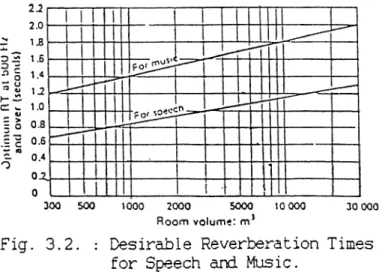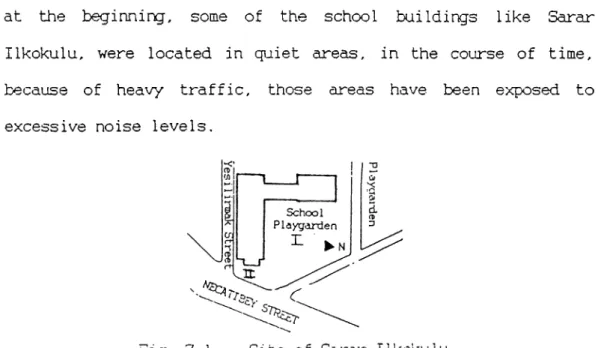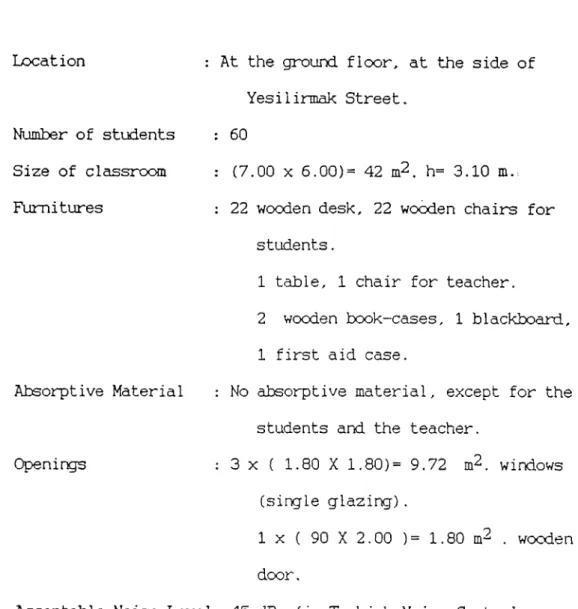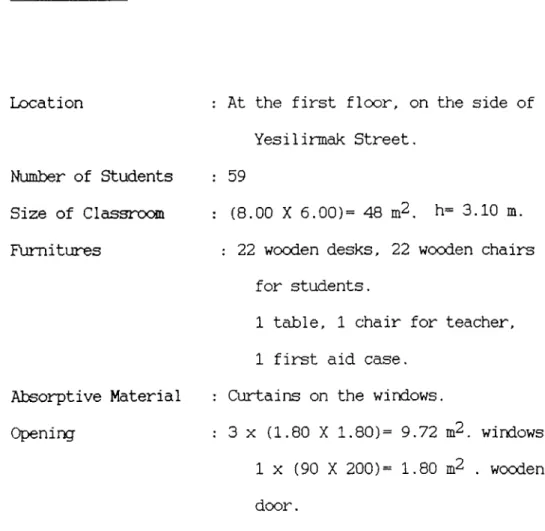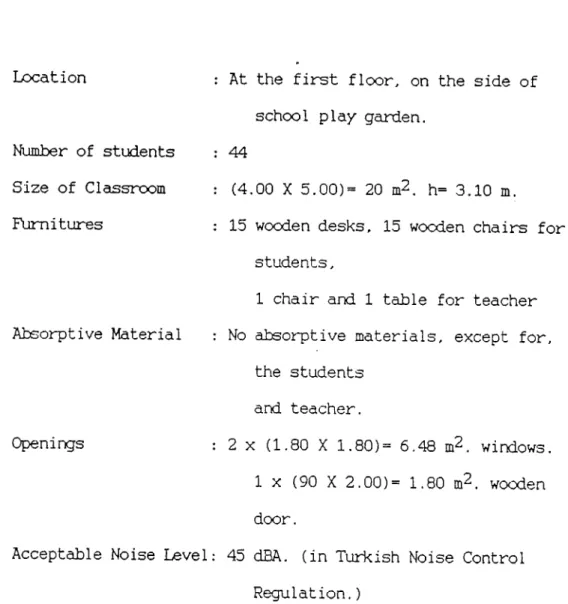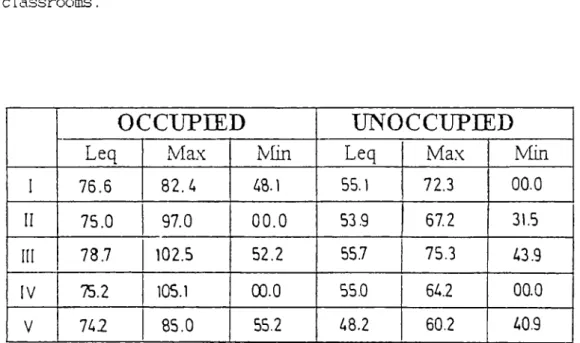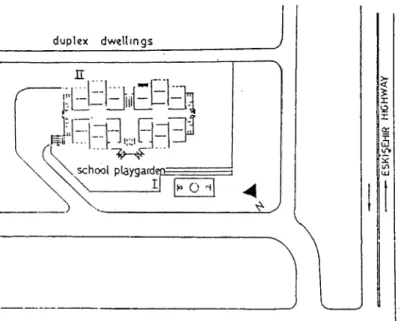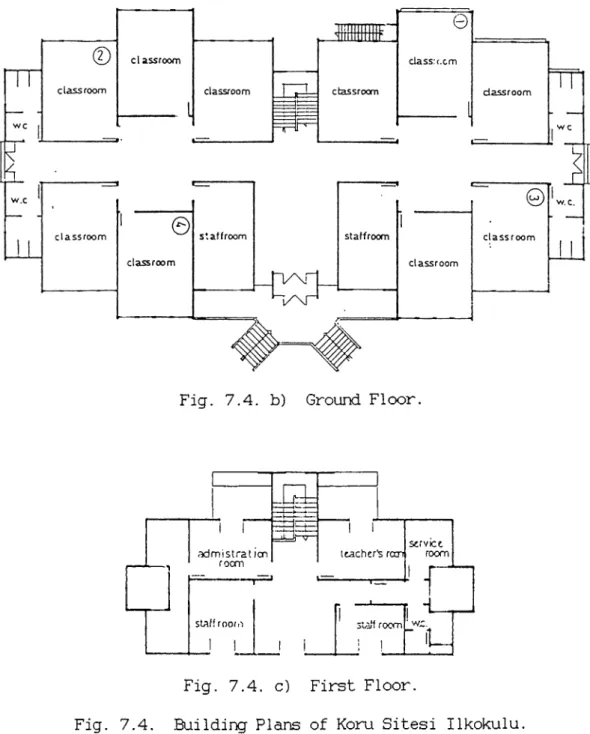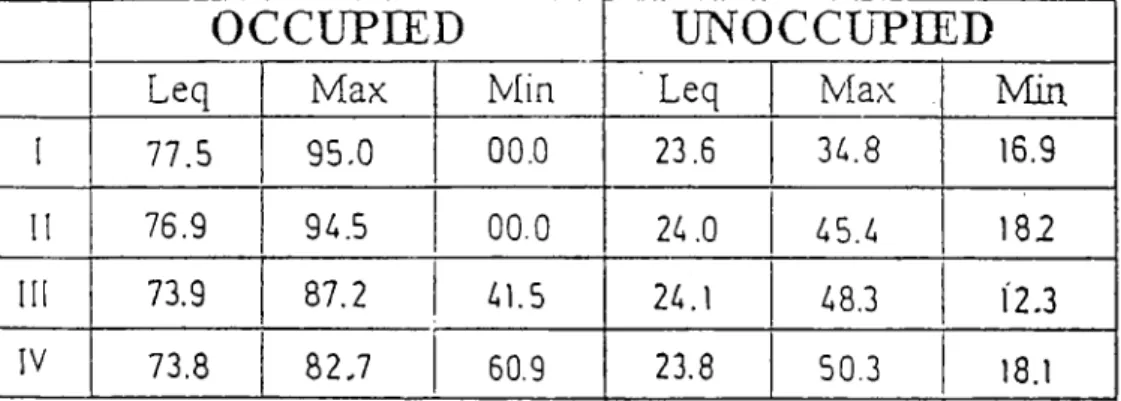.Z yf Уг-'^''У<'
NOISE PROBLEM IN PRIMARY SCHOOLS IN ANKARA
A THI^IS
SUBMITTED TO THE DEPARTMENT OF INTERIOR ARCHITECTURE AND
ENVIRONMENTAL DESIGN
AND INSTITUTE OF FINE ARTS OF BILKENT UNIVERSITY IN PARTIAL FULFILLMENT OF THE REQUIREMENTS
FOR THE DEGREE OF MASTER OF FINE ARTS
BY
AY5BGUL OZUPEK JUNE, 1994
I ІА
Ο^ΖΟΌ
I certify that I have read this thesis and that in my opinion it is fully adequate, in scope and quality as a thesis for the degree of Master of Fine Arts.
I certify that I have read this thesis and that in my opinion it is fully adequate, in scope and quality as a thesis for the degree of Master of Fine Arts.
Prof. Dr. Mustafa Pultar
I certify that I have read this thesis and that in my opinion it is fully adequate, in scope and quality as a thesis for the degree of Master of Fine Arts.
Assoc. Prof. Dr. Yıldırım Yavuz -r .
Approved by the Institute of Fine AStiis
Prof. Dr. Bülent Ozgüç, Director of the Institute of Fine Arts 11
NOISE PROBLEM IN PRIMARY SCHOOLS IN ANKARA
Ayşegül Özûpek M.F.A. In
Interior Architecture & Environmental Design Supervisor: Assoc. Prof. Dr. Cengiz Yener
June, 1994
In this study, the problem of noise in primary schools is
examined, by indicating the negative effects of this problem on the physiological, psychological, and social well-being of human beings, and on the effectiveness of teaching and learning
process. By proving the excessive noise levels in primary
schools in Ankara, it is aimed that, to take attentions of specialists to the subject of noise, and to make them consider this problem in the planning of new schools and in the renovation process of older school buildings.
Key Words: Primary schools. Noise, Sound, Acoustics, Noise
Control.
ABSTRACT
ÖZET
ANKARA'DAKİ İLKOKUL BİNALARINDA GÜRÜLTÜ PROBLEMİ
Ayşegül Özüpek
İç Mim.3rlık ve Çevre Tasarımı Bölümü Yüksek Lisans
Tez Yöneticisi: Doç. Dr. Cengiz Yener Haziran, 1994
Bu tezin amacı, ilkokullardaki gürültü problemini ve bu
gürültünün eğitimin verimliliğine olan olumsuz etkilerini ortaya koy.arak, okul binalarının mimari tasarımlarinda akustik acıdan gerekli Önlemlerin alınmasındaki önemi vurgulamak, ve yapılan
deneysel çalışmalarla ilkokullardaki gürültü problemini
kanıtlamaktır.
Anahtar Sözcükler: ilkokul. Gürültü, Ses, Akustik, Gürültü
Kontrolü.
ACKNOWLEDGEMENTS
First and foremost, I would like to thank Assoc. Prof. Dr. Cengiz Yener for his invaluable help, support and guidance, without which this thesis would have been a much weaker one, if not totally impossible.
I wish to express my gratitude to my parents Atila - Melahat OzLipek, without whose irr-eplaceable support, I would not have been able to put forth this thesis.
Finally, I would like to thank to all my friends for their sincere continuous support.
TABLE OF CONTENTS ABSTFÎACT OZET ACKNOWLEDGEMENTS TABLE OF CONTENTS LIST OF TABLES LIST OF FIGURES 111 iv V vi ix X 1. IKTRODUCTION 1.1. Problem
1.2. Methodology, F o m . and Structure of Thıesİ!;
1
1
3
2. EFFECTS OF NOISE ON HUMAN BEINGS ... 4
2.1. Physiological Effects of Noise 5
2.2. Psychological Effects of Noise ... 8
2.3. Social Effects of Noise 15
3. NOISE CONTROL 19
3.1. Sound Absorption 19
3.2. Sound Isolation ... 27
4. PRIMARY SCHOOLS ... 31
4.1. Definition and Function ... 31
4.2. Spaces in the Primary Schools ... 34
4.3. Classroom Interaction and Noise 35
5. NOISE IN PRIMARY SCHOOLS ... 41 ■
5.1. Internal Noise 44
5.1.1. Classrooms 46
5.1.2. Corridors and Stair^/ays 52
5.1.3. Gymnasiums 54 5.1.4. Dining Rcxams 56 5.1.5. Auditoriums 59 5.1.6. Libraries 62 5.1.7. Music Rooms 63 5.1.8. Swimming Pools ... ... 64 5.1.9. Service Rooms 65 5.1.10. Staff Rooms 65 5.2. ExiLemal Noise
66
6. POSSIBLE MEASURES WHICH CAN BE TAKEN IN PLANNING... 69
6.1. Site Selection ... 69
6.2. Building Layout ... 71
7. CASE STUDIES ... 74
7.1. Sarar ilkokulu ... 75
7.2. Koru Sitesi ilkokulu ... 92
7.3. General Evaluation 108 8. CONCLUSION 114 APPENDIX Definitions REFERENCES Vlll
LIST OF TABLES
Table Page
7.1. Sound Pressure Levels in Classrooms
of Sarar ilkokulu... 88
7.2. Sound Pressure Levels in Corridors of Sarar ilkokulu... 90
7.3. Sound Pressure Levels in Staff Rooms of Sarar ilkokulu... 91
7.4. Sound Pressure Levels in Classrooms of Koru Sitesi ilkokulu... 105
7.5. Sound F^essure Levels in Staff Rooms Koru Sitesi ilkokulu... 106
7.6. Sound Pressure Levels in Two School Buildings... 108
7.6. a) Sarar ilkokulu... 108
7.6. b) Koru Sitesi ilkokulu... 108
LIST OF FIGURES
Figure Page
3.1. Sound Decay Plot... 23
3.2. Desirable Reverberation Times For Speech and For Music... 25
3.3. Intrusive Noise EX.ie to Airborne Noise and Structure Borne Noise... 27
6.1. Principles of Citing Educational Buildings to Reduce E:<temal Noise Intrusion... 72
7.1. Site of Sarar ilkokulu... ....76
7.2. Building Plans of Sarar ilkokulu... 77
7.2. a) Plan of Ground Floor... 76
7.2. b) Plan of First Floor... 77
7.3. Site of Koru Sitesi ilkokulu... 93
7.4. Building Plans of Koru Sitesi ilkokulu... 94
7.4. a) Basement... 93
7.4. b) Ground Floor... 94
1.1. Problem
Elementciry school covei*s the first portion of school carrier of
every child. During the first years of education, children
learn through the elementary school program which is prepared by
the specialists. Child's learning process takes place as a
consequence of the interaction between the child, teacher, and
environment. In history of mankind, listening has been a vital
part of experience. In school, experiences in listening can
become an important facet of the child's learning. Through
speech, the listener hears facts, ideas, and feelings.
Most education begin with the ear. Even before the individual
words, a baby learns what a tone of voice means. But after a
while, words become the key to thought, so anything that
interferes with the teacher's words is a particularly dangerous
barrier in elementary years. When a child is just beginning to
listen effectively, it must not be made difficult for him to hear.
1. INTRODUCTION
The school was established to promote learning, which is
achieved largely by word of mouth and by listening. Thus,
acoustics is one of the most important physical properties that determine how well the school building can serve its primary
function. As a result, the exclusion of noise and the reduction
of reverberation are unavoidable in adapting classrooms to the fLinction of oral instruction. Classrooms are noisy, not only because of students, but simply because of the way they are constructed and finished.
Today, most of the primary schools in Ankara, suffer from the
noise which interrupts the teaching-learning process. Because
of wrong site selections, bad building plannings, lacking of
sound absorbing materials, increasing population, and
limitations in the number of primary schools, noise threats the physical, psychological, and social well-being· of students and teachers.
The importance of auditory conditioning in primary schools is growing, because many noisy activities such as music, games, and
shop work are common. Mostly, in the classrooms several
activities are going on simultaneously, although, none of them individually noisy, but together creating enough noise to be
considered. When there is lack of sound conditioning, childi'en
will expend excessive amounts of energy straining to hear. As
the day carry on voices rise, tension may increase, and some
behavior problems appeal". Appropriate noise control can prevent
this.
In this study, I will explain the physiological, psychological,
and social effects of noise on human beings. I will deal the
subject of noise problem in primary schools in a detailed
manner. After completing theoretical investigation, I would
case studies, in an experimental manner. And, I will suggest
some precautions to control noise in acceptable levels
determined by noise control regulations.
At the end of this study, I hope to prove the excessive noise levels in primary schools in Ankara, and I would like to take attentions of specialists, to the subject of noise in the primary schools, to bring them into action for cosidering this
problem, in the planning of new schools and in the renovation
process of older school buildings.
1.2. Methodology, Form and Structure of Thesis
In the thesis study, the subject will be examined in both
theoretical and experimental ways. The results of a literature
investigation constitudes the theoretical part of the study. In
the experimental part of the thesis, two case studies prove and
examine the noise levels in primary schools located in
completely different environments. Noise levels were measured
with a noise level meter (BSJ<2230), and they were printed with
a printer (B & K 2318 + ZR 0035).
The structure of the thesis:
(i) Problem Identification - Chapter I.
(ii) Literature Review - Chapter II. IV. V.
(iii) Design Considerations - Chapter III. VI.
(iv) Experimental Studies - Chapter VII.
(iiv) Conclusion - Chapter VIII.
Noise pollution is growing rapidly as a major environmental
concern. Cities with their noisy cars, trucks, motorcycles,
sirens, and bellowing factories are tremendously noisy places
and they are getting noisier. People living in cities are
constantly exposed to from moderately intrusive sounds of
neighbors, children, pets and television; to the high intensity
sounds of aircrafts, automobiles, trucks and construction
equipment.
It is not only cities or workplaces that are noisy. Even in
suburban areas, and even in school buildings, traffic and
airplane noise is becoming an increasing problem. Moreover,
modern technology has brought a constant noise inside out'
homes, offices and schools, with appliances such as hair dryers,
photocopying machines, printers, vacuum cleaners, air-
conditioners, stereo systems, television sets, and lawnmowers
preventing our peace and quiiet. Even if people try to get away
from it all, speedboats, snowmobiles, and minibikes attacks to our ears in the countryside.
2. EEFBJTS OF NOISE ON HUMAN BEINGS
Although all of us enjoy a high standard of living, we pay for
it in part through the noise our technology creates. All these
noises can have harmful effects on our hearing, our state of mind, and even our social relationships.
2.1. PHYSIOLOGICAL EFFECTS OF NOISE
Effects on Hearing
Helen Keller, who is mentioned by Wilson (1989), once said that
"...blirKiness cuts people off from things; deafness cuts people
off from people." A large segment of the population, however,
risks hearing damage due to noise exposure.
Benjamin and Hopkias (1987) states that "noise is defined as a
collection of sound frequencies that is disharmonious." Today,
it is known that, excessive noise levels can cause hearing problems and there are many individuals who have paid a terrible
price for being exposed to such sounds. "Although the exact
mechanisms are as yet not fully understood", says Benjamin and Hopkias (1987) "there is much evidence to show how excessively loud sounds produce problems in the ear's conductive mechanism, as well as auditory nerve damage." (89)
Most individuals do not give as much consideration to the risk
of hearing loss as they do to other risks. Possibly this is
because hearing damage occurs gradually in most cases, seldom as
a result of a single event accident. Most of the time, noise
induced hearing loss is first observed during audiometric
testing. More cotnmonly, the individual first becomes aware of a
problem when words are lost in face to face conversation and
telephone conversation. Rubin and McNeil (1985) states that;
"When the cells of the inner ear are
bombarded with loud sounds, they can be
relatively mild noise level of 70 dB., atout the level of a crowded business office can damage hearing if one is subjected to it for
a year. And higher levels of noise can have
much worse effects. Noise levels between 90
and 100 decibels put people at risk of
hearing loss, and noise levels of 120
decibels or more are clearly harmful to
hearing. When exposed to sounds of 130 dB.
or more, people actually feel pain." (127).
Exposure to noise of high pressure and high frequency creates
hearing damages on people either in the form of temporary
hearing impairment or permanent hearing impairment.
Temporary hearing impairment: Continuously exposure to noise
for a complete day creates hearing impairment on the individual
after leaving the noisy environment. Since, the noise induced
hearing impairment is temporary in this situation, after a
while hearing ability of individual becomes its normal level. This is called temporary hearing impairment or hearing fatigue.
Permanent hearing impairment: Exposure to high levels of noise
for a long time causes the permanent hearing impairment. This
is called noise induced deafness. Noise,induced hearing losses
are most commonly due to the depletion of hair cells, which can not be replaced. (Davidoff, 1987.)
As Rubin and McNeil (1985) states, sometimes people can produce damage in their ears by listening sounds that they enjoy.
Effects on Physical Health
Noise is by definition unwanted and therefore frustrating and
Tarnopolsky, "it alters the functioning of cardiovascular,
endocrine, respiratory, and digestive systems." (McLean &
Tarnopolsky, cited in Encyclopedia of Psychology). Most of these
reactions have been documented in laboratory studies involving
short term exposure to relatively high sound levels. (A. Cohen,
cited in S. Cohen and Weinstein, 1981). Since such changes, if
extreme, are often considered potentially hazardous to health,
many feel that pathogenic effects of prolonged noise exposure
are likely. Physiological changes produced by noise consist of
nonspecific responses typically associated with stress
reactions. (Glorig, Selye, cited in Cohen and Weinstein, 1981).
A recent review of the industrial noise literature concludes that there is elevated morbidity among people who have been
exposed at work to sound of 85 dBA or greater for at least 3 -
5 years. People who have been exposed to unpredictable,
intermittent, impulse sound tends to have greater morbidity than
to periodic, continuous, or relatively steady sound. Morbidity
affects those whose work involves mental concentration more than those who do mainly manual work. (Welch, cited in Cohen and Weinstein, 1981)
Welch argues that the strongest case for industrial noise impacting health derives from the research on cardiovascular
problems. He interprets the data (over 40 different studies)
to indicate that long term work under high intensity sound is
associated with at least a 60 percent increase in risk of
cardiovascular disease. Impairs at the regulation of blood
concomitants of prolonged routine exposure to intense industrial sound include cardiac morbidity, poor peripheral circulation, and elevated cholesterol levels.(Cohen, 1981)
There are number of studies reporting increased gastrointestinal
complaints for noise exposed people. Reported problems include
gastrointestinal ulcers, chronic gastritis, and general
digestive problems. High noise levels has also been associated with increased reports of sore tliroats and laryngitis and increased job related injuries.(Raytheon Service Company, cited
in Cohen and Weinstein, 1981) In addition, because of increased
noise levels pregnancy complications and decreases in the
health and survival of newborn infants has been associated. ((Ando 6i Hattori, cited in Cohen and Weinstein, 1981)
Other studies report noise associated increases in nervous and gastrointestinal diseases, consumption of sleeping pills, and visits to doctors, and self reported incidence of a variety of chronic illnesses. ( Cameron, Robertson & Zaks, cited in Cohen and Weinstein, 1981 )
2.2. PSYCHOLOGICAL EFFECTS OF NOISE
Effects on Snotional Health
When it comes to predicting psychological effects, there is an
important distinction to be made between sound and noise. When
psychologists talk about "noise", they are referring to sounds that are unpleasant or unwanted. ( Cohen and Weinstein, cited in
Rubin &. McNeil, 1985) As a result, what is noise remains to a certain extend in the ear of the beholder. Some people find loud
rock music enjoyable (and hardly noisy), and loud opera music
annoying (and therefore noisy); other people have exactly the opposite reaction.
More generally, what is perceived as tolerable sound or
intolerable noise depends on peoples attitudes toward the source
of the sound. In one study, Sorenson found that people living
next to an air forcebase were less annoyed by the aircraft sounds when they were persuaded that the base was a vital part of their community and country. (S<orenson, cited in Rubin & McNeil, 1985)
Some researchers have suggested that prolonged exposure to noise makes people more vulnerable to anxiety, irritability, and even
emotional breakdown. "People, exposed to high noise levels,
report experiencing greater tension, more conflict with other
people at home and on the job, and more psychosomatic
complaints, such as nausea .and headaches." (Miller, cited in Rubin and Mcneil 1985)
Many investigations show that, when people are continually
exposed to noise, they are likely to adopt to it. Indeed, some
people in very noisy places seem almost neglectful to the noise. But even in such cases, the noise is likely to have harmful
effects. In one series of studies, David Glass and Jerome
Singer (1973) played students tape recorded bursts of either loud ( 110 dB.) or soft (56 dB.) noise over a period of 20
minutes. After a short while, the subjects adapted to the
noise, and they were able to perform clerical tasks
successfully. But the loud noise has unwelcome after effects.
Immediately after the noisy period, subjects who have heard the loud noise were impaired in their ability to work efficiently on
problem solving and proofreading tasks. (Cohen and Weinstein,
1981).
In their studies Glass and Singer found that, the predictability and controllability of the noise made a big difference in subjects" reactions to it. When it is known by the subjects, when the loud noise was coming, its harmful aftereffects were
greatly reduced. (Cohen and Weinstein, 1981). And the subjects
knew they could stop the noise if they wanted to, the effects were also reduced — even though the subjects didn't actually
make use their stop button. (Rubin and McNeil 1985),
Unfortunately, most of the noise that pervades our living and
working environments is of the worst kind— it comes in
unpredictable bursts, and it comes from sources over which we have no control.
Effects on Intellectual Abilities
Long term exposure to noise can also have adverse effects on
intellectual abilities. In one study, Cohen, Glass, and Singer
(1973) examined the relationship between a child's auditory and
verbal skills and the noisiness of his/her home. In this study,
greater impairment of auditory discrimination and reading
achievement than children living in higher floor apartments.
Glass and Singer suggest that in tuning out a noisy environment, children may fail to distinguish between speech relevant sounds
and speech irrelevant sounds. The unhappy result is that the
longer children must endure noise, the more likely they are to ignore all sounds, and this, in turn, may make reading more difficult.
Another study compared children who attended school near an airport, where they were subjected to the noise of aircraft lardings and take-offs at unpredictable times, with children who attended an otherwise similar school in a quieter neighborhood . At both schools, the children were tested in a soundproof trailer. Children from noisy school found it harder to solve puzzles and math problems and were more likely to give up in irritation. These children were also found to have higher blood
pressure than those in the quieter school. Some of these
effects of noise do not seem to disappear quickly. A few
classrooms in the noisy school were soundproofed. When the
children were tested a year later, those who had soundproofed classrooms did better on the puzzles and problems than those who remained in the noisier rooms, but they still do not persist at difficult tasks for as long as the children from the quiet classrooms from the other neighborhood. (Cohen et. al., 1980)
The noise levels of homes can also have important effects on
cognitive abilities. In one study, Wachs found that infants
example with kitchen appliances near the children's" rooms and the TV left on all day— scored lower on tests of intellectual development than did infants raised in otherwise comparable
homes that were not so noisy. ( Wachs, cited in Rubin and
McNeil, 1985).
Noise and Human Performance
The relationship between noise and performance depends on the
kind of noise and the type of performance. Moreover, accurate
prediction of noise performance relationships also requires an emphasis on the meaning of the sound and the social context of the setting for the person performing in noise.
Theories about the relationship between the noise and
performance have been subjected to considerable changes in the
last 25 years. Recently, there are three approaches to this
relationship; those are Broadbent, Cohen and Poulton.
Broadbent (1971) has argued that exposure to moderate and high
intensity noise causes an elevation in arousal. Heightened
arousal is said to cause to a narrowing of one's attention. As
arousal increases, attention is restricted and task relevant
cues may also be neglected. In some tasks, proficiency,
demands the use of only a restricted range of cues. Such tasks
improve with moderate narrowing of attentional focus to the
extend that computing cues are no longer noticed. In other
tasks, proficiency demands the use of a wide range of cufes. Any
performance negatively. It follows that optimal level of
arousal varies with the complexity of the task. Optimal levels
of arousal for complex tasks are lower than those for simple tasks.
S. Cohen (1978), like Broadbent, predicts attention focusing will often occur under high intensity noise, txit explains the
focusing as a strategy commonly used to decrease the amount of
information processed when one's processing capacity is
overloaded by the combined demands of the stressor (the noise)
and the origoing task. Cohen also argues that, the information
load set under noise exposure is affected more by the meaning of the noise and the situation, than by the intensity of the sound. He suggests that predictability and the controllability of the noise and one's expectancies about its effects are important
factors to consider. S. Cohen ( 1980) also emphasizes that even
if one accepts Broadbent's argument that attentional focusing occurs because of hightened arousal, it is likely that, the level of arousal is determined by the meaning of the noise and situation, not merely by the physical parameters of the sound.
Poulton (1978, 1979) argues that there is an increase in arousal
when continuous noise is first switched on , but that the
arousal gradually lessens over time. He also asserts that, this
initial increase in arousal often results in improved
performance. Poulton also suggests that reported decreases in
task performance under continuous noise occur because of
subject's inability to hear acoustic cues that aid performance
irregular noise are attributed to the distraction that occurs at the beginning of the noise.
Decrements in performance occur -in levels of noise higher than
95 dBA- under certain conditions. Task deficiencies are most
likely to occur when (1) the signals are hard to see, (2) the
situation is not one that encourages caution, i.e., one in which
even the most doubted judgment should be reported, (3) the
length of the watch is long, and (4) there are a number of
sources from which the signal may come. (Cohen and Weinstein,
cited in Encyclopedia of Psychology).
Scholastic Performance During Noise: Noise in classrooms
interferes with the teaching - learning process, thus resulting
in a progressive deficit. Several recent studies compare the
scholastic achievement of children attending schools near urban
airports to that of children attending schools in quieter
areas. A study showed that children attending noisy (in flight
path) schools showed a cumulative deficit in tested achievement
compared to children in quiet control schools. Bronzaft and
McCarthy (1975) similarly found that, children in classrooms on the side of a school facing train tracks performed more poorly on a reading achievement test than children in classrooms on the
quiet side of the building. (Cohen and Weinstein, 1981) Since
the noise interferes with the teaching learning process, it
creates problems for the students and for the teachers. For
example, noise may decrease teaching time by forcing teachers to continuously pause or by making it difficult for the student and for teacher to hear one another. (Crook & Langdon, cited in
Cohen end Weinstein, 1981) Other possible explanations include noise - produced influence on children's infonnation processing strategies, on their feelings of personal control and on their
level of arousal. (Cohen et a l ., 1980)
Aftereffects of Noise on Human Performance: Recent studies
indicate that, there are effects of noise on human performance
that occur after noise exposure is terminated. ( Cohen, 1980) For example. Glass and Singer (1981) found that in comparison with a control group not previously exposed to noise, subjects
exposed to unpredictable , 108 dBA or 56 dBA noise showed less
tolerance for frustration and performed more poorly on both
proofreading and a competitive response task. Noise
aftereffects are principally related to cognitive factors - predictability and controllability of the sound- rather than to acoustic parameters.
3.2. SOCIAL EFFECTS OF NOISE
Noise and Helping
The noise in an environment also affects the way people relate
to other people. Various studies have shown that people are
less likely to be helpful and friendly to others in noisy
places. In 1975, Kenneth Mathews and Lance Canon set up a
field experiment to investigate this phenomenon. As people
walked down a residential street, they encountered a group of
the experimenters who "accidentally" dropped several books. In
other half it was turned off. When the lawnmower was off, half of the passerby helped pick up the books; when it was going, only one - eight of the passerby came to the strangers aid.
Why should the noise of a lawnmower influence people's desire to
help? The most reasonable explanation seems to be ■ that the
noise distracts the attention of the passerby. Noise in the
environment makes it harder to take in any other information. Because of the noisy lawnmower, the passerby were lees able to pick up on the cues indicating that the person needed help.
(Cohen and Weinstein, 1981)
Noise and Friendship
Noise influences oui'· friendship as well. In a study in San Francisco, residents of lightly trafficked, quieter streets were found to have three times as many friends and twice as many social contacts on the streets than residents of comparable but
more heavily trafficked streets. On a busy street, casual
conversation with neighbors is unpleasant, if not impossible.
As a result people on the noisy street made fewer friends. In
fact, they described it as " a lonely place to live ".
(Appleyard and Lintel 1, cited in Cohen and Weinstein, 1981).
Conclusion: As it has seen , noise deafens us, stresses us,
impedes intellectual performance, and reduces our sense of
fellowship and community. The effects of noise on human can be
emphasized in two themes. The first theme has to do with the
predictability·, controllability, and meaning of the noise, in mediating the relationship between noise and human response. The second theme involves the possibility that the masking of auditory communication .
The ability to predict and control the occurrence of the noise
mediates both psychological and physiological response. Hence,
unpredictable noise is more likely to disrupt performance, to
lead to variable performance, to be reported as annoying, and to be linJ<ed with pathological response, than predictable noise, one's perception that a noise is controllable, i.e., that it can be escaped or avoided, can eliminate post-exposure deficits in
task performance and interpersonal sensitivity. Perceptions of
control also play a role in reported annoyance and may be an
improving factor in noise induced disease.
The respondents perception of the noise in a particular
context is also important in the relationship between noise and
hiunan response. Noise that is perceived as disn.iptive of an
important goal, unnecessary, and representative of something
that is feared or opposed and is produced without concern for the respondent is more likely to bring out stress related responses than noise without these characteristics.
The masking of auditory communication provides a possible
explanation for a niunber of reported effects, particularly the
harmful effects of noise on human performance. It is obvious
that a task whose performance requires auditory communications
will suffer under high intensity noise. Noise masking of
responsible for the poorer scholastic performance among children
living and/or attending school in noisy neighborhoods and
masking of supervisor worker or worker-worker communication
may be partly responsible for increased incidence of accidents
for those working in noisy industrial settings. It also seems
likely that decreased social interaction under noise may be wholly or partly due to one's expectancy that communication would be difficult under noisy conditions.
In sum, it is clear that prolonged exposure to high-intensity
noise in community or work settings is often harmful to the
health and behavior of large segments of the exposed
The exclusion or reduction of noise and vibration damaging to human comfort, health, well-being and productivity is termed
noise control. Noise control should be examined under two
headings; one is sound absorption and the other is sotind isolation.
3.1. SOUND ABSORPTION
Absorption is a property of materials that reduces the amount of
sound energy reflected. Thus, the introduction of an absorbent
into the surfaces of a room will reduce the sound pressure level in that room by virtue of the fact that sound energy striking the room surfaces will not be totally reflected. Irrelevant signals or noise can be partially suppressed through the
subtractive action of absorption. This action produces a
decrease in the pressure of a reflected sound relative to the pressure or intensity of the incident signal.
3. NOISE œNTTÎOL
The rate at which sound is absorbed in a room is a prime factor
in reducing noise, controlling reverberation, and achieving
speech intelligibility. All materials used in the construction
of buildings absorb some sound, but proper acoustical control often requires the use of materials that have been especially
designed to function primarily as sound absorbers. Such
materials are, popularly known as 'acoustical' materials, and they are used for the reduction of the noise in hospitals, schools and many other buildings.
When the designer needs a material to reduce or dampen the internal noise level, a porous or soft material that will permit
sound waves to penetrate will be the suitable one. This
penetration causes sound to lose energy by friction before it reenters the room.
Sound is absorbed by a mechanism which converts the sound into
other forms of energy and ultimately into heat. Most
manufactured materials depend largely on their porosity for
their absorptivity. Many materials, such as mineral wools,
pads, and blankets, have a multitude of small deeply penetrating
inter-communicating pores. The sound waves can readily
propagate themselves into these pores, where a portion of the
sound energy is converted into heat by frictional resistance
within the pores and by vibration of the small fibers of the
material. If the material is sufficiently porous, and of
appropriate thickness, as much as 95 per cent of the energy of an incident sound wave may be absorbed in this manner.
There are three basic types of sound absorbents: 1) porous
absorbents, 2) membrane absorbents, and 3) resonant absorbents.
1) Porous Absorbents: If an airborne sound wave is incident
upon a porous surface, the vibrating particles are restricted by the pores. Because of the friction created between the pores of
material, and the sound wave, some of the sound energy converted into heat. In order for this absorption to take place, it is obviously necessary for the vibrating air to be able to enter the pores of the surface material.
2) Membrane (Panel) Absorbents; Lawrence (1989) also states
that "If a relatively thin, airtight material is fixed at some
distance from a rigid surface, it will exhibit
characteristic resonances..." (109) A sound wave striking on an
airtight system, it will force the system into vibration. Since
the thin panel is fixed at its edges, there will be some sound energy converted into mechanical energy, and thus absorbed. However, since the panel is itself set into vibration it will re-radiate energy back into the room: thus its efficiency as an absorbent is limited.
Practical panel absorbents tend to be most effective in the low frequency range. Generally, as the surface density of the panel and/or the depth of the air space between the panel and the rigid surface increase, the frequency of maximum absorption decreases. If it is required to broaden the effective absorbent frequency range, it is necessary to place some porous absorbent material in the air space.
Panels, if made of sufficiently durable and flexible materials like pressed wood fiber or paper boards, plywood, or plastic boards, can be employed for ceilings, covering, or even for the
entire walls of rooms where low frequency absorption is
small rooms, such as music studios, classrooms and offices, reduce the amount of additional absorption required for optimum reverberation.
3) Resonator Absorbents: It is well known that ceramic pots and jars with openings to the air were built under seats in ancient Greek theatres and into some walls of medieval mosques and
churches for acoustic purposes. Simple resonators are named
after Helmholtz who first described their characteristics. A
Helmholtz resonator consists of a volume of contained air in the
room through a constricted neck and opening. The striking sound
energy causes the air in the neck to vibrate, and because of its constricted volume, the sound energy is diminished because of
friction in the resonator. Absorption can be increased by
placing light porous material across the mouth or, to a lesser
extend, by placing absorptive material in the chamber.
Helmholtz resonators are most effective over a narrow frequency range, normally at low frequencies.
REVERBERATION
If sound is generated in an initially quiet room, the sound level will grow due to reflections until equilibrium is reached. At that time, the rate of sound energy generation will equal the
rate of energy absorption. If the sound generation is stopped,
the sound level will decay to the original quiet background
level. By measuring the rate of sound decay, one may determine
the amount of absorption in a room, a value that is of practical importance in acoustics and noise control.
c
a
Fig. 3.1.
Time (i)
Sound Decay Plot
Reverberation is the effect of noise bouincing back and forth
from the walls, ceiling, and flcKcr of an enclosed room. The
reverberation time of a room is the time in seconds for sound level to decay by 60 dB. after sound soijrce is tuiTied off
(Figure; 3.1.). Reverberación time is frequency dependent, and
is usually measured for each octave band or one-third octave band. The general effect of reverberation is to blur speech so that the control of reverberation is perhaps the most important factor in the acoustic design of a room.
The reverberation time depends on ;
1. the power of the sound at the beginning
2. the absorbency of surfaces or objects with which it comes into contact during interreflection
3. the volume of the interior and therefore the length of the sound path
It is known that, the greater the power, the greater the volume and the higher the frequency, the reverberation time will be
longer. The greater the total absorption of the room, the
shorter will be the reverberation.
SPEECH IhTIERFERENCE
When noise interferes with communication, it robs us of one of
our most important human attributes. Wilson (1989) quotes from
a report of the Environmental Protection Agency that; "...
Interference with speech communication by noise is among the
most significant adverse effects of noise on people. Free and
easy speech communication is probably essential for full
development of individuals and social relations, and freedom of speech is but an empty phrase if one cannot be heard or understood because of noise..."
In the design of rooms intended for speaking purposes the prime objective is the realization of conditions that will provide
good intelligibility of speech. This phrase signifies how well
speech is recognized and understood. In order to obtain good
acoustics in a room some requirements are listed below:
1. All noises, whether of outside or inside origin, should be reduced to levels that will not interfere with the hearing of speech or music.
2. The room's shape and size should be designed to a) give proper diffusion of the sound,
b) reinforce the sound reaching the listener, especially toward the rear seating area.
Although these desirable conditions are also affected by the distribution of the absorptive materials and by the sound amplification system, they are largely controlled by the ^shape
and size of the room. It is often necessary to design special
wall and ceiling surfaces to act as reflectors for the
reinforcement of sound at the rear of the room, and it is sometimes essential to introduce some surface irregularities to provide proper diffusion of sound.
3. Arrangements should be made for reinforcing the speech and music in a room (figure; 3.2. ), so that the sound level will be adequate in all parts of the room.
300 500 ) 000 2000 5000 10 000
Room volume m*
30 000
Fig. 3.2. ; Desirable Reverberation Times
for Speech and Music.
In a small room this requirement can be met by the proper design of reflective surfaces; in a large room, in addition to the proper design of the reflective surfaces, a high-quality sound amplification system is indispensable.
Masking: When one sound is made inaudible by another sound, or when speech is made unintelligible by noise, the process is called masking.
Most of the intelligibility in speech is contained in the frequency bands between 200 Hz. and 6 KHz., while some speech sounds have frequencies lower than 200 Hz. and some are higher
than 6 KHz. Thus, noise in the 200 Hz. and 6 KHz. range is most
objectionable in terms of speech masking. However, loud noise
in any frequency band can adversely affect speech
intelligibility by overloading the auditory system so that it cannot discriminate the speech content from the total signal presented.
The understanding of speech is dependent on two qualities: power
and clarity. It is obvious that the point of receptionall, or
nearly all, speech sounds should have sufficient loudness for oral interpretation.
This requirement presents a major problem in the design of large auditoria, especially when it is borne in mind that some of the
discrete sounds in speech have very little power at the
beginning. It is probably true to say that, even in a classroom
a listener at the back of the room is dependent on ‘guessing
from context' for some of the words spoken. Inevitably there
will be a loss of power due to distance but, further losses can be minimized by good design.
3.2. SOUND ISOLATION
Sound can propagate throughout a building either via the air or
via the buildings structure (Figure; 3.3.). Sound generation
mechanisms can therefore be divided into two general groups. As
a result, sound transmissions from one place to another, can be prevented by 1) sound insulation, and by 2) vibration isolation.
SCXJND INSULATION; Sound insulation is the reduction of sound energy achieved by a structure such as a partition separating a
noise source from a quiet area. The word insulation is only
vibration) and the term sound insulation usually implies the net reduction in sound when it is transmitted by all available sound paths, such as the walls, building framework and ductwork,
connecting the two rooms. When a single transmission path is
considered, as for example through a partition separating two rooms, the natural ability of the partition material to resist the transmission of sound is defined in Britain by its "sound
reduction index". The alternative American terminology "sound
transmission loss" is far more explicit.
The installation of absorbing materials on the ceiling or walls of the receiving space will have only a marginal effect in
limiting the penetration of external noise. In fact, the porous
and the lightweight character of most sound absorbing materials
seriously limits their value as sound insulators. Heavy
materials are required, for the effectiveness of a sound-
insulating barrier will depend on its weight or mass, its
stiffness and its air tightness.
The effectiveness of any structure as an insulator is determined by the following four parameters:
1. Weight
2. Homogeneity and unifo3rmity 3. Stiffness
4. Discontinuity and isolation
1. Weight: The weight of a wall is the primary consideration in
all design for sound insulation. Whenever it is likely that
structure, their weight should never be under-estimated and provisions for supporting the mass of heavy partitions should be
made in the preliminary planning stage. The acoustic mass law
relates the superficial weight of a partition to its
transmission loss. In general, there is an increase in
insulation of about 5 dB. for each doubling of weight.
2. Homogeneity: The efficiency of sound insulation depends not
only on the weight but on the completeness and uniformity of the
structure. If there is a hole in the barrier the sound energy
or pressure is released and flanking transmission will pass through the hole, seriously degrading the total performance of the partition.
3. Stiffness: Stiffness of a material can be defined as, the
materials resistance to deformation. At very low frequencies
the stiffness of the panel, and therefore its resistance to
deformation, may have more effect than its weight. In this part
of the frequency range insulation is said to be stiffness
controlled. Complex lightweight partitions having rigid foam
plastic or honeycomb cores will often be found to e>iiibit very good low frequency insulation due to their inherent stiffness. Where high insulation performance is required, a sheet lead is a very good example with its ratio of weight to stiffness.
4. Discontinuity and Isolation: Sound which reaches the
receiving room via more orderless paths is termed flanking or
indirect sound transmission. The significance of even small air
demountable partitions, doors and windows, poor joints in builders' work, common ceiling hollows and ventilation ductwork
with openings into both spaces, etc. causes unwanted sound
transmission from one place to another.
VIBRATION ISOLATION: It is a term that is reserved for the case of noise transmission originating at impacting or vibrating sources. The technics of reducing the vibration input to the
building structure is termed vibration isolation. The most
familiar impact source is footsteps upon a floor surface; other
examples include crashing doors and vibrational excitation
originating at machinery. Vibration isolation is to a certain
extend related to sound insulation, but the ability of a
partition to resist impact noise is highly dependent on the
character of the surface receiving the energy. For example,
footstep noise transmitted tlrrough a floor slab can be reduced by doubling the thickness, and thereby the weight of the slab, but it may be more effectively controlled by using a resilient
floor covering, such as carpet, thick rubber or cork.
Alternatively, a floating floor may be used consisting of a timber or concrete raft laid on resilient layer, such as glass
wool. This solution has the added advantage of increasing the
airborne sound insulation of the floor structure, as it has the features of a discontinuous cavity construction.
4. THE PRIMARY SCHOOL
4.1. DEFINITION AND FUNCTION
Elementciry school covers the first portion of the school career of each child which is spent in the kindergarten and the first
five grades. During this first years of his/her education,
child learns through the elementary school program which is prepared by the specialists and teachers.
Too often the school program is considered as an accumulation of
courses or subjects. While reading, writing and arithmetic, as
well as science, social studies, music, art, and physical
education, are prominent aspects of the school program, they are
not the entire program. There are many other areas of learning
which can not be so simply organized into subjects or courses, includiiig those with such objectives as the development of citizenship, respect for property, respect for the rights of others, ability to work cooperatively, good work habits, and
other desirable attitudes, appreciations, and habits too
numerous to list here. Some of these are developed
coincidentally with the development of skills and the mastery of
content in organized courses. Others are even more intangible
and their realization must come bit by bit from various phases of the total complex of actions and reactions of pupil to pupil, pupil to teacher, and pupil to total school environment.
Children are the reason for the existence of the schools. Whatever contributes to happy school experiences for children and opens the way to real life and growth individually, in their school groups, in their communities, in their nation, and in
their world should be of prime concern to the school. It is the
school's obligation to direct the wide range of attitudes, interests, urges, and needs into the most promising channels.
Society has evolved two ways to meet this obligation. One is by
transmitting to the present generation carefully selected parts of the accumulated culture and knowledge of the ages up to the present, with directions for using this heritage beneficially
and adding to it if possible. The other is by developing the
present generation of children individually and collectively to function efficiently in the activities of the democracy and the world in which they live.
Good elementary education reflects a skillful blending of
happiness, scholarship, and subject matter. There ai-'e two
principal sources of purposes of education: first, the
identification of certain human needs — either individual or
societal; and, second, the education of human behavior. In
specifying purposes, therefore, it is important to focus
particularly upon these aspects of need which might best be
satisfied through predictable behavior changes. Since education
is a true form of growth and development and is, therefore, a highly individualized process, such aims should be stated in
terms of attainability by each individual pupil. Ten major
effective elementary school curriculum. The following are the goals of elementary schools :
1. To help a student develop honesty with himself and others, and to develop within the student the desire for honest and consistent effort.
2. To help a student develop a self image that is positive and
realistic.
3. To help a student develop the skills that are needed in a
rapid and changing society.
4. To develop the power of independent thought and creative
expression.
5. To provide for an equal learning opportunity for all students.
6. To develop the awareness of the insepiarability of freedom
and responsibility.
7. To help each student to develop effective basic
communication skills: literary skills of reading, writing, speaking, listening and computation.
8. To help each child develop a clarification and understanding
of his values that will allow him to make a contribution to society.
9. To develop in each student a feeling for the challenge and
importance of learning.
4.2. SPACES IN THE PRIMARY SCHOOIS
The school program is the main factor in determining the type of the building; the kinds of spaces; the size, shape, arrangement, and equipment of the various spaces; and many other features of the building.
Beyond the classrooms and other teaching stations where most of the group instruction takes place, there are numerous other
rooms and spaces provided in a m o d e m elementary school
building. Some of the more common facilities are now discussed
urder the following headings:
1. Non classroom facilities for pupils.
Library; activity rooms for staff, student council, and similar student activities; lounges and other social rooms; assembly dramatics and speech facilities, including auditoriums, little theaters, audio visual rooms, broadcasting studios, and the
like; cafeteria or lunchroom; gymnasium facilities; locker,
shower, and dressing rooms; other indoor athletic facilities; clothing storage; toilets and restrooms; health service rooms; outdoor facilities like, tennis courts, football fields.
2. Administrative offices and staff rooms.
The administrative office requirements vary greatly from school
to school. Private offices, general offices, other central
office space, quarters for guidance workers, conference rooms, storage rooms are offices which exist in most of the elementary
for conferences, the staff members need separate rooms where they can work in privacy, relax or rest on occasion, and attend
their personal needs. Teacher's offices and workrooms,
teacher's lounges, quarters for other staff members and lunch facilities should be offered to the staff in the educational settings.
3. Custodial and service facilities.
The facilities required for the operation and maintenance of a
large school building are many and varied. Heating plant,
receiving and storage rooms, custodian's rooms, elevators and lifts, communication system, parking facilities are important spaces of an educational building.
4.3. CLASSROOM HTTERACriON AND NOISE
The learning of anything, is essentially an individual
achievement, an exploitation of the capacities of the mind to
make sense of the environment. But typically this private
process takes place in the public context of the classroom, the individual is one of a group, a member of the class, and the activities which are to set the process in train is determined
by the teacher. As Malamah-Thomas (1987) states that "...this
internal process of learning will come about as a consequence of the interaction which takes place between the two kinds of participant: the teacher on the one hand, and the learners on
the other." (vii) . The only purpose of the classroom
